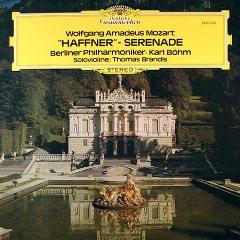Mozart - Haffner Serenade (Bohm) [1973]
Mozart - Haffner Serenade (Bohm) [1973]

01] Serenade in D major I. Allegro maestoso - Allegro molto 02] Serenade in D major II. Andante 03] Serenade in D major III. Menuetto 04] Serenade in D major IV. Rondeau- Allegro 05] Serenade in D major V. Menuetto galante 06] Serenade in D major VI. Andante 07] Serenade in D major VII. Menuetto 08] Serenade in D major VIII. Adagio - Allegro assai 09] Masonic Funeral Music K477 Berliner Philharmoniker Karl Bohm - conductor
Mozart composed this eight-movement work at Salzburg in July 1776, "for the wedding of Signor Spath and Signorina Elisabetta Haffner." It is scored for solo violin (in movements 2-4), pairs of flutes, oboes, bassoons, horns, and trumpets, plus string choir. This lengthy serenade is the first of two that Mozart composed for the Haffner family. Father Sigmund was both a rich merchant and burgomaster, whose ennoblement in 1782 occasioned the second one, since lost (four movements of which, however, survive as the Symphony in D [No. 35], K. 385, likewise called "Haffner" although neither label was the composer's). Counting the lost "Haffner," Mozart wrote 12 serenades in his lifetime, a title he used interchangeably with divertimento, cassation, and concertone -- works in as many as eight movements, usually for special occasions of a social rather than formal character, usually performed in diverse venues over a period of several hours. Literally translated, serenade means "evening music," apt in the case of K. 250/248b which was performed by an ambulatory orchestra throughout the evening of July 21, 1776 (the wedding of Haffner's daughter, Maria Elisabeth, to Franz Xaver Späth followed on July 22). Mozart himself played the violin solos in movements 2, 3, and 4 -- a concerto in all but title -- and conducted the remainder.
Although less formal than symphonies or hold-over suites from the Baroque period, serenades were not, in Mozart's case, either casual or off-hand creations. Indeed, the consensus is that the "Haffner" Serenade was his breakaway work for orchestra. H.C. Robbins Landon has called it "Mozart's first great orchestral work -- that is, the first in which technical ability and musical genius are perfectly wedded." For Jens Peter Larsen it "was the most stately orchestral piece that Mozart had so far composed...a work at whose artistic perfection one can only wonder." Georges Saint-Foix found in it "the full blossoming of his rarest gifts of music and poetry...the climax, not to say the apotheosis, of the period we have designated as galante."
Mozart experimented with key-combinations in his serenades. While K. 250/248b is nominally in D major, the second movement (Andante) is in F; so is the fourth movement (Rondeau), and the trio of movement 3 (Menuetto). The song parts of movement 3, however, are in G minor, the darkest key in Mozart's vocabulary; and the sixth movement (Andante 2) begins in A major! Robbins Landon again: "Those who know the later Mozart will find in K. 250 passage after passage in which the music of the Vienna period is presaged: the sudden veil drawn over the music by a harmonic change; the gliding poignancy of chromatic passing notes; the profoundly disturbing emotional quality that underlies so much of the apparently gay atmosphere -- all of these are marks of Mozart's mature and supremely individualistic style." --- Roger Dettmer, Rovi
download: uploaded yandex 4shared mediafire solidfiles mega zalivalka filecloudio anonfiles oboom








